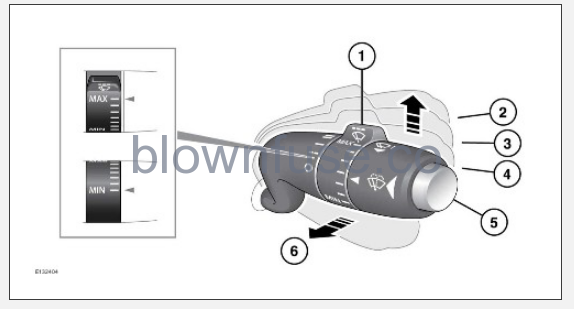2022 Jaguar F-TYPE Wipers And Washers Owners Manual




2022 Jaguar F-TYPE Wipers And Washers


WIPER OPERATION


Do not operate the wipers on a dry windshield, as it may damage the wiper blades.
Remove any snow, ice, or frost from the windshield, around the wiper arms and blades, and the windshield scuttle before operating the wipers. Failing to do so may cause damage to the wiper blades.
To avoid damage to the wiper blade, do not lift the wiper by the wiper blade. Always lift the wiper by the wiper arm.
To avoid damage to the hood, do not lift the wipers when they are in the normal parked position. See WIPERS SERVICE POSITION.
Make sure the wipers are switched off before entering a car wash. If the automatic rain sensing system operates during the car washing process, damage may occur to the wiper mechanism.
In freezing or very hot conditions, make sure that the wipers have not stuck to the windshield before operating. Failing to do so may cause damage to the wipers.
If the wipers leave smears on the glass after the vehicle has been washed, this may be due to wax or another residue. Should this occur, clean the glass with the recommended windshield cleaning fluid. See LUBRICANTS AND FLUIDS.
The windshield is no longer wiped effectively and the automatic rain-sensing function degrades if the wipers become worn. Always replace worn or damaged wiper blades as soon as possible.
If the wiper blades become stuck or jammed, an electronic cut-out may temporarily halt wiper operation. If this happens, switch off the wipers and the ignition. Clear any obstructions and free the wiper blades before attempting to switch on the ignition.
- Rotate the collar to adjust the sensitivity of the automatic rain sensing mode when the position (4) is selected. The higher the sensitivity position, the more responsive the system becomes.
When automatic rain sensing mode is selected, or when sensitivity is increased, the system performs a single wipe.
- High-speed continuous wipe.
- Low-speed continuous wipe.
- Automatic rain sensing mode: The front wipers respond and adapt automatically to ambient rain conditions, selecting the appropriate wiper frequency for the prevailing conditions. Rotate the collar (1) to adjust the sensitivity of the system.
- Windshield washer button: Press and release to operate the front washers and wipers. The wipers perform a number of normal speed wipes, followed by a drip wipe if configured. The washer operates during the first few wipes.
If the washers are operated with the wipers operating at normal or fast speed, the washer jets operate for a few wipes, and operation of the wipers is not affected.
- Single wipe of the windshield, or hold for further continuous wipes.
SPEED-DEPENDENT MODE
If the vehicle’s speed drops below approximately 1 mph (2 km/h) with the wipers operating, the wipers switch to the next lowest speed. When the vehicle’s speed increases to over approximately 5 mph (8 km/h), the original wiper speed setting is restored.
The speed-dependent mode can be enabled or disabled by a retailer/authorized repairer.
RAIN SENSOR
The rain sensor is mounted on the inside of the windshield, behind the rear-view mirror. The sensor is able to detect the presence and amount of water on the windshield and automatically activates the windshield wipers accordingly.
Static droplets may not be detected on initial start-up. A single wipe should be used to clear the windshield.
The rain sensor can be enabled or disabled via the Vehicle settings menu. See INSTRUMENT PANEL MENU OPERATION.
To activate the rain-sensitive wipers, move the wash/wipe control to the automatic rain-sensing mode position (4). Rotate the collar (1) to adjust the behavior of the system to suit the driver’s preference.
In dry and often sunny conditions, optical influences and dirt accumulation on the windshield may result in the windshield wipers activating inadvertently. To prevent this, it is recommended that under these conditions the wash/wipe control is returned to the off position.
TIMED JET FUNCTION
If the timed jet function is configured, the washer jets only operate on the upstroke of the wipers.
The timed jet function can be enabled or disabled by a retailer/authorized repairer.
DRIP WIPE
If the drip wipe feature is configured, the wipers operate a few seconds after a wash and wipe cycle has finished. The drip wipe feature clears any remaining drips from the windshield.
The drip wipe feature can be enabled or disabled by a retailer/authorized repairer.
HEADLIGHT WASHERS
- The headlight power wash operates automatically with the windshield wash. The headlight power wash operates only if the headlights are switched on and there is sufficient washer fluid in the reservoir.
- The headlight wash operates with every fourth operation of the windshield washers. The headlight wash operates provided the headlights are still switched on and approximately 10 minutes have elapsed since the last headlight wash.
- Switching the headlights or the ignition off and back on again resets the cycle. See LIGHTING CONTROL, or SWITCHING OFF THE ENGINE.
Recent Posts
VW Jetta Engine Fuse Box Diagram
Access the comprehensive 2010-2018 VW Jetta Passenger Fuse Box Diagram to troubleshoot electrical issues effectively.…
VW Jetta Passenger Fuse Box Diagram
Explore the comprehensive VW Jetta Passenger Fuse Box Diagram to troubleshoot electrical issues effectively. Understand…
2023 Ford F-150 Lightning Fuse Box Diagram
Under Hood Fuse Box Location Remove the front luggage compartment cover. Under Hood Fuse Box…
2022 Kawasaki NINJA H2 SX SE Brake Lever Adjuster Owner’s Manual
2022 Kawasaki NINJA H2 SX SE Brake Lever Adjuster Owner's Manual NOTICE Only adjust the front…
2023 Land Rover Range Rover Evoque Exiting The Vehicle Owners Manual
2023 Land Rover Range Rover Evoque Exiting The Vehicle SINGLE LOCKING WARNING Before exiting the…
2023 Land Rover Range Rover Evoque Front Seats Owners Manual
2023 Land Rover Range Rover Evoque Front Seats FRONT SEAT SAFETY Make sure to read…
